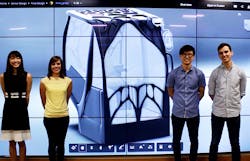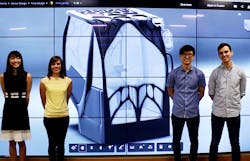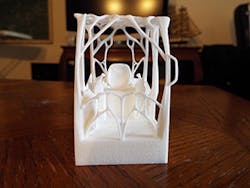Students Make Strides in 3D Printing Construction Equipment
During the 2014 International Manufacturing Technology Show (IMTS) in 2014, Local Motors—along with Oak Ridge National Laboratories (ORNL) and a number of companies—succeeded in 3D printing a car. Following that success, ORNL plans to 3D print an excavator at next year’s CONEXPO CON/AGG. “There is a lot of interest in large 3D printing of metal parts. We are stepping forward and saying we are presenting this at the show to acts as an accelerator to push ourselves,” says Lonnie Love, group leader for the manufacturing system research group at ORNL.
A large, strong boom with built-in hydraulics is being printed right at the show. The excavator of the boom will be built in one print to reduce assembly time, resources, and fasteners. ORNL also will leverage topographic optimization (TO). With 3D printing’s ability to handle complex geometries, material can be minimized to only cross-members and structures that are necessary to carry loads. Reducing all unnecessary materials will greatly reduce cost and print time.
In addition, students at the University of Illinois won a nationwide design contest to 3D print the cab of the excavator. This team recognized that the current cab has panels for vibration and sound dampening. In response, air pockets were worked into the 3D printed model, allowing for efficient use of structural supports while doubling as sound and vibration dampening.
The 3D printer will have a build space of 8 ft. by 20 ft. by 6 ft. It will deposit 100 lb. of carbon fiber-reinforced ABS per hour. At about $4/lb., reducing material cost is essential—especially when competing with a material such as steel, which is consistently under $1. (According to Quadl.com, the cost was about $0.10 per lb. on June 13, 2016). The students plan to reduce materials by using a 75% fill. They used TopOpt and ParetoWorks (a program that operates inside of SolidWorks) to take advantage of the same TO techniques used for the boom. TO will probably be a common theme throughout this build.
After a semester of designing, the team integrated the controls directly into the model and printed a 1/16th scale model to win the competition. The students will join Oak Ridge as they use the CONEXPO-CON/AGG in March 2017 as a public testing ground to print the complete, full-size boom. The team of students won thanks to their ability to leverage new technology to offer a creative design that offered safety, ergonomics, manufacturability, and aesthetics. The Judges included representatives from Bobcat, Caterpillar, CNH, Donaldson, and Eaton. Each team member will receive a $2,000 cash prize, donated by the National Fluid Power Association (NFPA). In addition, they traveled to Oak Ridge National Laboratory in Tennessee on Sept. 17 to observe the printing of their design.
The team includes students Naomi Audet (noise and vibration reduction, and FEA), Kevin Kim (safety and material testing), Luke Meyer (structure and material testing), Andrew Peterman (loading conditions and FEA) and Sharon Tsubaki-Liu (topology optimization, 3D modeling); faculty advisor Sameh Tawfick; and senior design course instructor Blake Johnson.
A video of the winning design submitted by the UIUC team can be seen here.
The Additive Manufactured Excavator (AME) project is a collaboration between The Association of Equipment Manufacturers, NFPA, CCEFP, ORNL and NSF which partnered with Georgia Tech and the University of Minnesota to sponsor the nationwide cab design contest.




